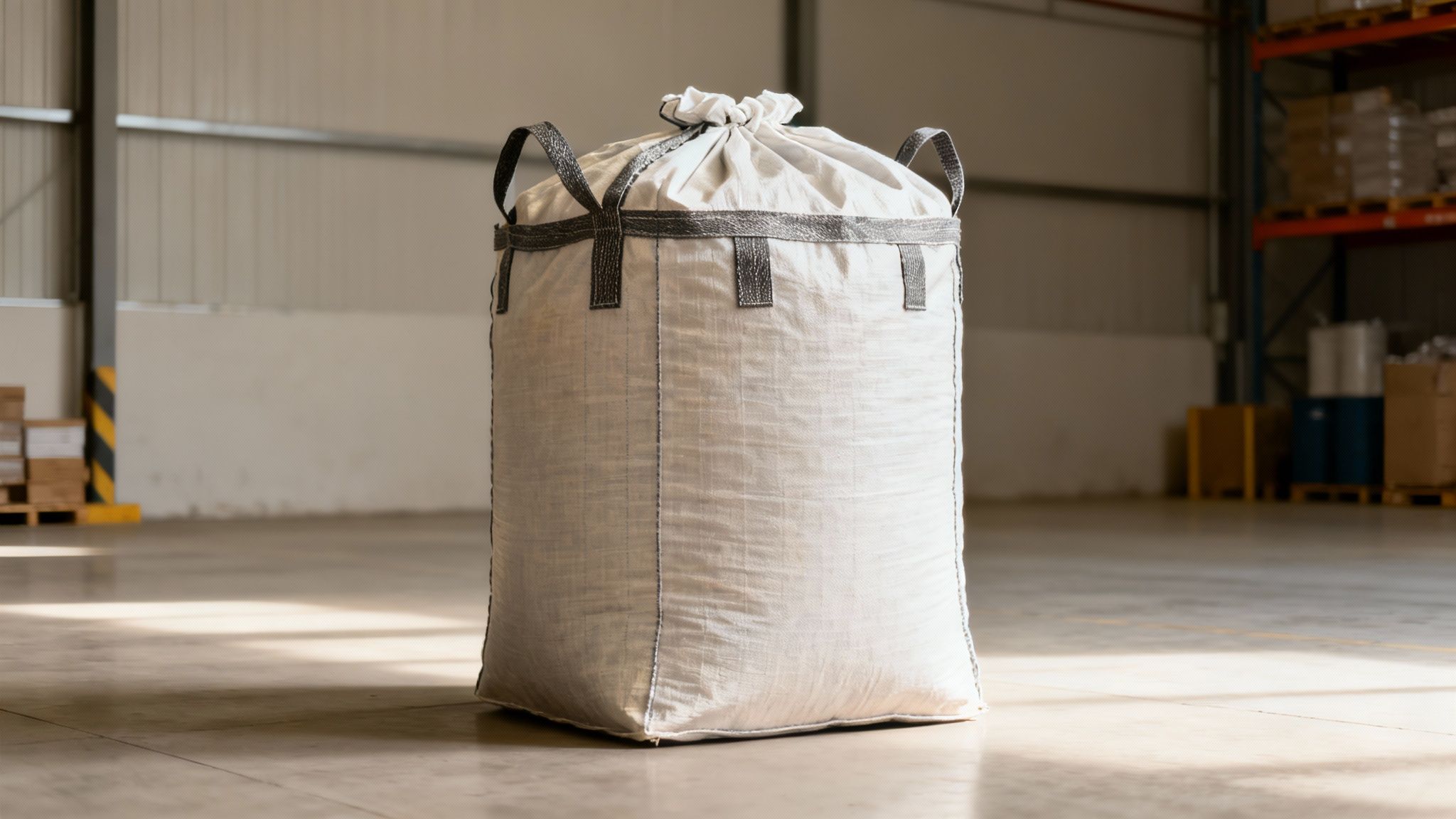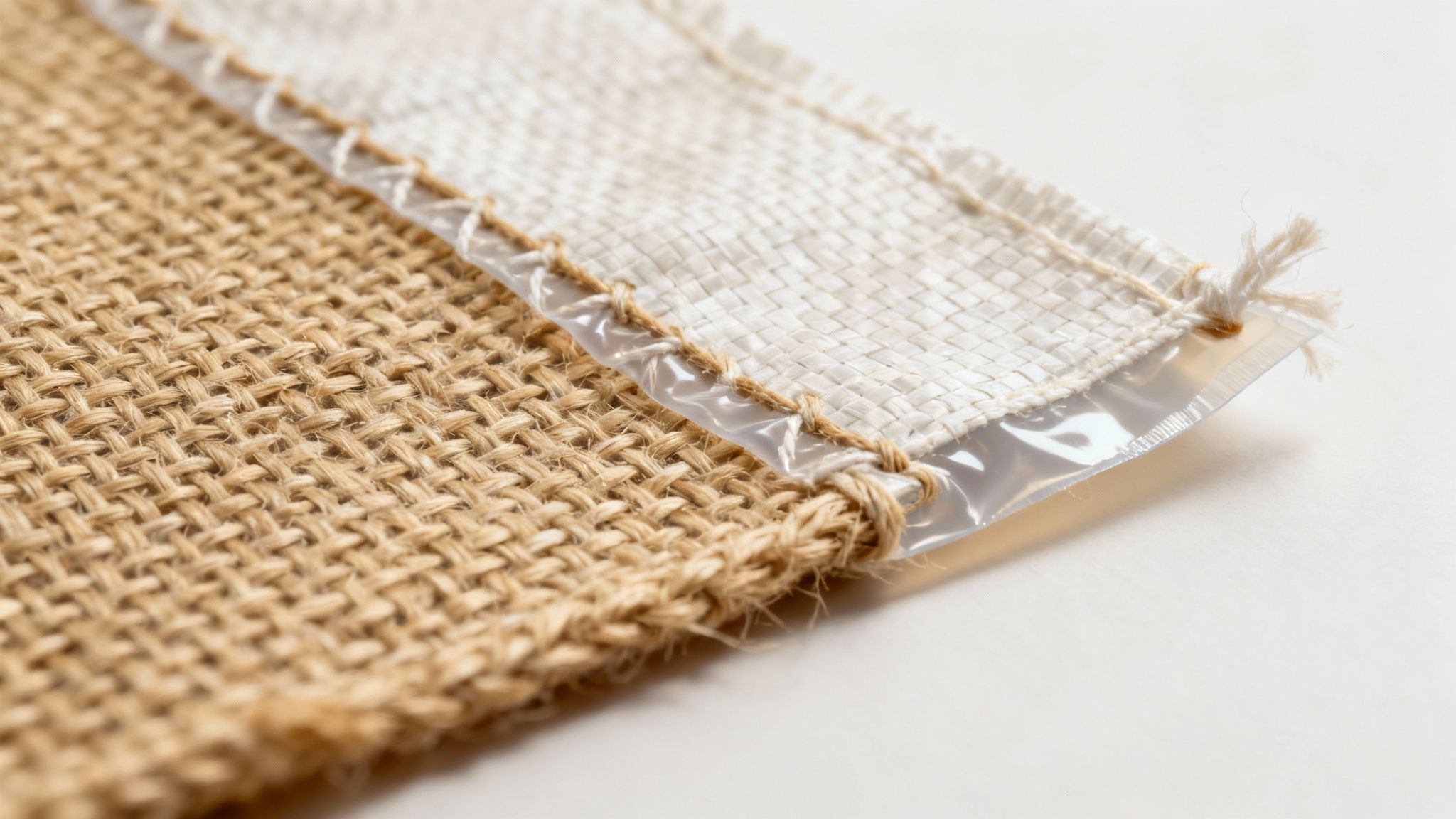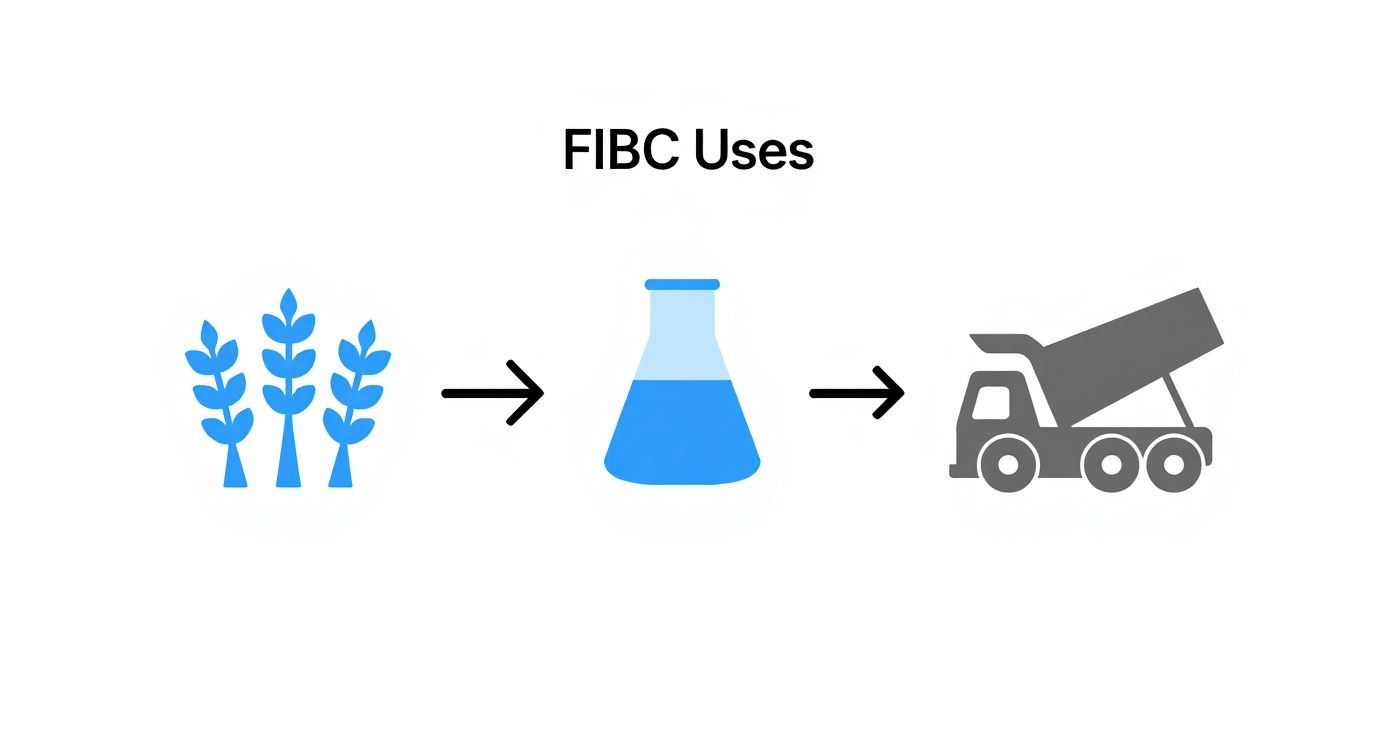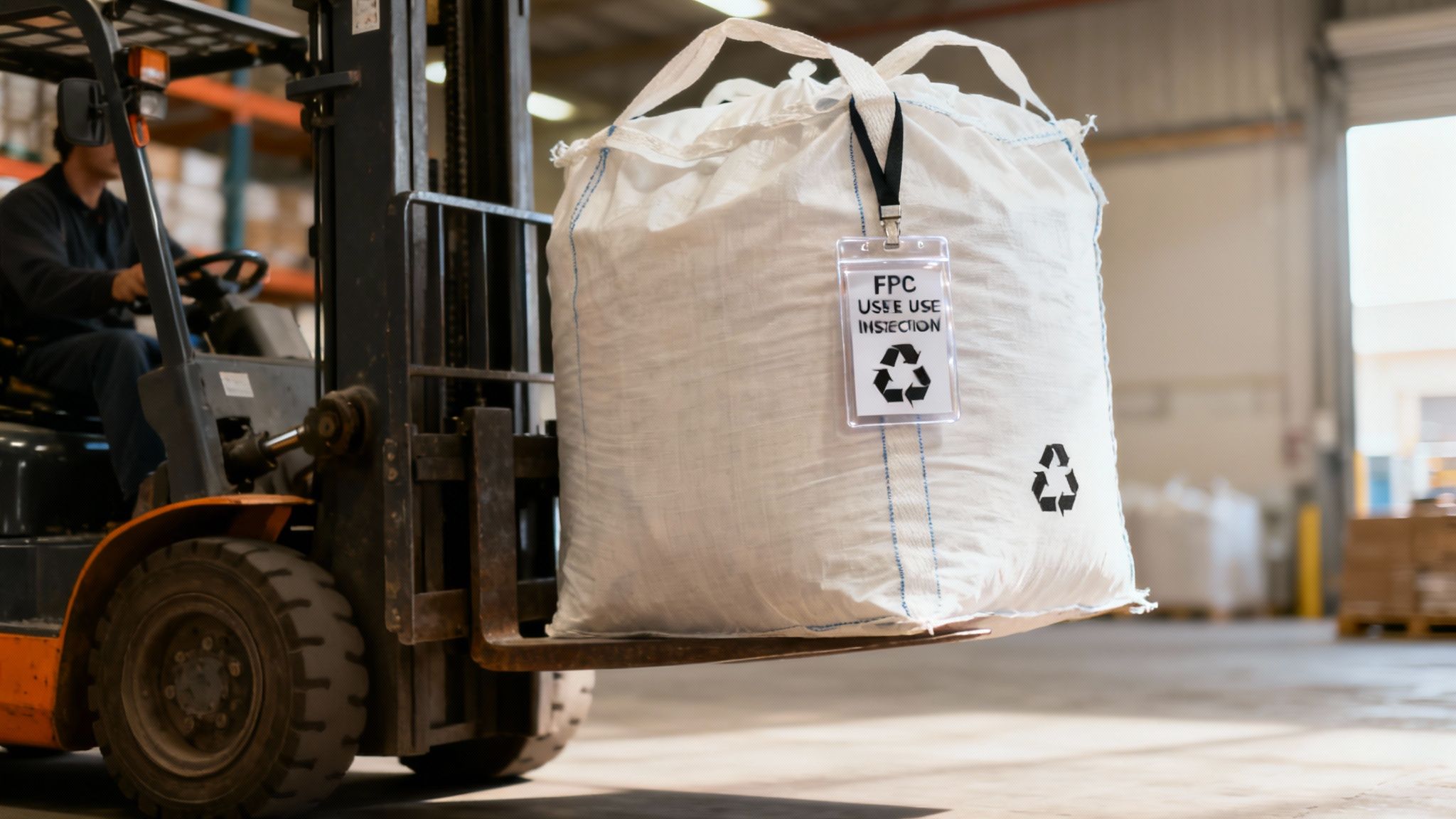Your cart is currently empty!
Tag: industrial packaging
-
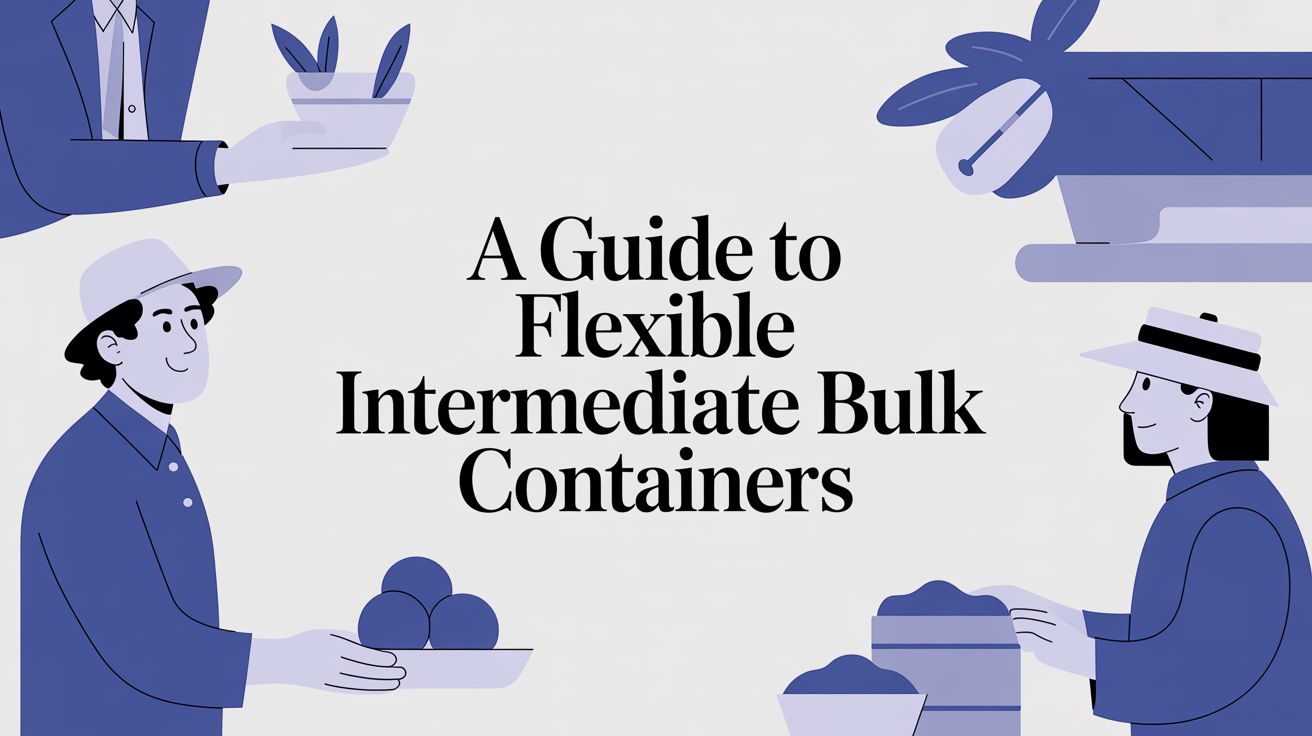
A Guide to Flexible Intermediate Bulk Containers
Ever seen those massive, white woven bags on construction sites or at a farm? Those are Flexible Intermediate Bulk Containers, or FIBCs for short. Think of them as the workhorse of the bulk material world—giant, industrial-strength tote bags designed to handle everything from fine powders and grains to construction aggregates.
They’re a game-changer for anyone moving large quantities of dry, flowable goods.
What Exactly is a Flexible Intermediate Bulk Container?

At its heart, an FIBC is a big, tough, woven fabric bag made for industrial-scale storage and transport. You’ll hear people call them "bulk bags" or "super sacks," and for good reason. They neatly bridge the gap between shipping products in countless small sacks and using expensive, heavy rigid containers.
Let’s put it into perspective. Say you need to move one metric ton of fertilizer. You could fill and seal 40 separate 25 kg bags. That's a lot of handling, stacking, and manual labour. Or, you could do the entire job with a single FIBC, cutting down your handling time and costs in a huge way. That efficiency is precisely why they've become so popular.
The numbers don't lie. The North American FIBC market was valued at a whopping USD 5.16 billion in 2024. It’s expected to climb to USD 8.71 billion by 2033, growing at a solid clip of around 5.98% each year. This boom is fueled by constant demand from the chemical, food, and manufacturing sectors. For a deeper dive, plenty of industry reports track this market's impressive growth.
The Basic Anatomy of an FIBC
So, what holds these bags together? The design is surprisingly simple but incredibly effective. Every part is built for strength and practicality, ensuring they can safely manage massive loads.
A standard FIBC is made up of a few key components:
- Body Fabric: The walls are woven from polypropylene, a tough plastic fabric that resists tearing. It’s surprisingly lightweight for a material that can hold thousands of kilograms.
- Lift Loops: These are the heavy-duty straps stitched firmly into the top corners. They’re designed for forklift tines or crane hooks to grab, making it easy to lift and move the bag without ripping the body.
- Top and Bottom Construction: Bags come with different options for filling and emptying. Some have a spout on top for clean filling, while others have a spout on the bottom for controlled discharge. Simpler versions might just have a flat bottom that you cut open.
The real genius of the FIBC is how it combines a lightweight, collapsible body with strong, built-in lifting points. This gives you a cost-effective and space-efficient way to handle bulk materials, often without needing pallets.
This straightforward but rugged design makes FIBCs a go-to solution in dozens of industries, from agriculture and food processing to mining and pharmaceuticals. They are designed to be filled, moved, and emptied using the equipment most companies already have, which is why they’ve become such a fundamental part of modern logistics.
When you're looking to store or ship bulk materials, you'll eventually face a key decision: should you go with a flexible FIBC or a rigid IBC tote? At first glance, they both seem to solve the same problem, but they are fundamentally different tools designed for very different jobs.
This choice isn't just about the container itself. It directly impacts your warehouse space, how much you spend on shipping, and the overall rhythm of your operations.
Think of it like choosing between a heavy-duty duffel bag and a hard-shell suitcase. The duffel bag (our FIBC) is light, can be squashed down when empty, and adapts to whatever you stuff inside. The suitcase (the rigid IBC) gives you solid, uncompromising protection but takes up the same amount of room whether it's packed or not. Grasping this simple difference is the first step to making the right call for your business.
How They Handle Space and Logistics
The most obvious difference between the two is what happens when they're empty. A rigid IBC has a fixed shape. An empty 1,000-litre tote occupies the exact same footprint as a full one, which can be a real headache when you're short on warehouse space.
FIBCs, on the other hand, are completely collapsible. Once you've discharged the product, the bag folds down into a neat, flat package, instantly freeing up precious floor space. This is a game-changer for return logistics. You could ship hundreds of empty, folded FIBCs back in the space that just a few empty rigid totes would gobble up.
The core trade-off is between the structural integrity of a rigid container and the space-saving, lightweight nature of a flexible one. Your product and your operational flow will determine which attribute provides more value.
This difference also shows up on the price tag. FIBCs typically have a much lower upfront cost per unit than rigid IBCs. This makes them a very budget-friendly option, particularly for one-way shipments where you don't expect to get the container back. For a deeper dive into the world of bulk containers, our guide on bulk container IBCs has more detailed information.
Matching the Container to Your Product
Your product is the single most important factor in this decision. Rigid IBCs, with their tough high-density polyethylene (HDPE) inner bottle, are the clear winner for liquids. From water and food-grade syrups to industrial-strength chemicals, their sealed design and sturdy walls are perfect for secure containment.
Flexible intermediate bulk containers are built for an entirely different purpose: handling dry, flowable products. This covers a massive range of materials, including:
- Fine Powders: Think cement, flour, or chemical pigments.
- Granules: Such as plastic resins, fertilizers, and agricultural seeds.
- Aggregates: Things like sand, gravel, and even construction debris.
While you can’t pour liquid directly into a standard FIBC, you can add specialized liners to protect dry goods that are sensitive to moisture. This little bit of adaptability makes them incredibly versatile for just about any dry solid you can think of.
A Head-to-Head Comparison
To really see the differences, let's put them side-by-side. This quick comparison helps clarify where each container shines.
Flexible FIBCs vs Rigid IBC Totes At a Glance
The table below breaks down the key characteristics and common uses for both flexible and rigid IBCs, helping you pinpoint the best fit for your needs.
Attribute Flexible IBCs (FIBCs) Rigid IBCs (Totes) Primary Use Dry, flowable bulk solids (powders, granules) Liquids, semi-solids, and some solids Storage When Empty Folds flat, minimal space required Fixed dimensions, requires significant space Shipping Costs Lower due to light weight and collapsible design Higher due to heavier weight and fixed size Initial Cost Lower per unit Higher per unit Reusability Can be multi-trip (6:1 safety factor) but often single-use Designed for multiple uses and long service life Handling Requires forklift with proper attachments Standard pallet jack or forklift handling In the end, choosing between flexible intermediate bulk containers and rigid totes isn’t about which one is "better." It's about which one is better for you. By carefully looking at your product, your storage setup, and your budget, you'll be able to select the container that brings the most value and efficiency to your operation.
A Closer Look at FIBC Materials and Construction

It’s easy to look at a flexible intermediate bulk container and see just a big, simple bag. But there’s a surprising amount of engineering packed into its design, allowing it to safely handle thousands of kilograms of product without bursting at the seams. The magic is in the material and how it’s put together.
The workhorse material for virtually every FIBC is woven polypropylene. It’s the go-to choice for a reason: it’s incredibly strong for its weight, holds up against a wide range of chemicals, and is economical to produce. This combination makes it ideal for the rough-and-tumble world of industrial bulk handling.
Think of it as an industrial-grade textile. Thin but tough polypropylene tapes are woven together into a solid, tear-resistant fabric. The tightness of that weave—measured in ounces per square yard or grams per square metre—is precisely matched to the bag’s target Safe Working Load (SWL). A denser weave means a stronger bag, plain and simple.
Core Construction Styles That Define Strength
The way these sheets of woven polypropylene are assembled is just as important as the fabric itself. Different construction styles are designed to manage the immense stress of the load in specific ways, each with its own set of advantages.
You'll generally come across three main designs in the field:
- Circular Woven: These bags are made on a circular loom, which creates a seamless, tube-like body. With no vertical seams as weak points, the stress is distributed very evenly. This design is fantastic for preventing fine powders from leaking out.
- U-Panel: True to its name, this style is built from one long piece of fabric that forms a "U" shape, creating two sides and the bottom. Two more panels are then sewn on to form the other two sides. The result is a sturdy, reliable bag that holds a square shape well when filled.
- Four-Panel: This is a classic construction method. Four individual side panels are stitched to a separate square piece for the bottom. This design is excellent at keeping a consistent square footprint and is often used for heavy-duty applications that demand maximum durability.
The choice between a circular or panelled design isn't just about looks; it’s an engineering decision. The construction directly influences how the FIBC handles the downward and outward forces of its contents, preventing bulges and potential seam failures.
This smart engineering is exactly how a bag that weighs just a few kilograms can confidently hold a full metric tonne of material.
Specialized Features for Demanding Jobs
Beyond the core structure, flexible intermediate bulk containers can be kitted out with all sorts of features to handle specific jobs. These enhancements can protect the product inside, make handling easier, or guarantee purity.
One of the most common upgrades is a polyethylene liner. Think of it as a "bag within a bag." This liner acts as a critical barrier against moisture, oxygen, and outside contaminants. For industries like food, pharmaceuticals, and fine chemicals where product integrity is everything, liners are non-negotiable. They can be loosely inserted, tacked to the inside, or even fully formed to fit the FIBC's shape perfectly.
Protection from the elements, especially for outdoor storage, is another key consideration.
Coatings and Additives for Durability
Polypropylene is tough, but it can get brittle and degrade when left in the sun for too long. To solve this, the fabric is treated with a UV inhibitor. This additive helps the material resist breaking down from ultraviolet rays, giving the bag a much longer life when stored outdoors.
For an extra layer of protection, the fabric itself can be coated. A very thin layer of polypropylene is laminated onto the fabric, sealing the tiny gaps in the weave. This makes the bag water-resistant and helps prevent fine powders from sifting out—a must-have feature for products like cement or certain agricultural goods that need to stay bone-dry.
How Key Industries Use FIBCs Every Day
You can read spec sheets all day, but the real story of flexible intermediate bulk containers is told on farms, factory floors, and construction sites across the country. These bags are the quiet workhorses of the supply chain, solving practical, everyday problems for some of the world's most vital industries.
Once you see how different sectors put FIBCs to work, you’ll start to get a feel for how they could simplify your own operations. Their use is incredibly varied—from delicate food ingredients to rough-and-tumble building materials, FIBCs can be adapted to handle just about anything.
Agriculture: From Seed to Harvest
In the world of agriculture, everything comes down to protecting your product and getting the job done efficiently. Think about a seed supplier gearing up for planting season. Instead of wrestling with thousands of small paper sacks, they can load a single, one-tonne FIBC with premium seeds. That one bag keeps the contents safe from moisture and pests all the way from the warehouse to the field.
When it arrives at the farm, that same bulk bag can be lifted by a tractor and positioned right over a planter. The spout at the bottom gives the farmer total control over the flow, which means less manual labour and almost no spillage. The same simple, effective process applies to:
- Fertilizers: Evenly distributing nutrients across massive fields.
- Grains: Moving harvested crops like wheat, corn, or soybeans from the combine to the silo.
- Animal Feed: Delivering bulk feed to livestock operations without risk of contamination.
Chemical and Pharmaceutical Manufacturing
For the chemical industry, safety and precision are the name of the game. When you’re dealing with fine powders, some of which can be hazardous, you need a container that won’t leak and can manage the risks of static discharge.
For example, a company producing a powdered chemical additive would use a Type C conductive FIBC. These specialized bags have conductive threads woven directly into the fabric. During filling and emptying, the bag must be grounded. This simple step prevents a static spark from building up and igniting flammable materials, ensuring the whole process is safe from start to finish. You can learn more about how we support the safe handling of materials with our guide on chemical IBC totes.
In fact, the chemical and petroleum sectors are dominant users in North America. These industries accounted for approximately 37.4% of the total intermediate bulk container market revenue in 2021, driven by the need to safely transport potentially hazardous materials. Discover more insights about this market data from Grand View Research.
Food and Pharmaceutical Purity
In industries where purity is everything, there's no room for compromise. That’s where specialized food-grade and pharmaceutical-grade FIBCs come in. These bags are made in certified cleanroom environments to eliminate any chance of contamination. Everything—from the polypropylene fabric to the sewing thread—has to meet strict regulatory standards.
Picture a spice processor importing bulk peppercorns. They’d use a food-grade FIBC fitted with a polyethylene liner. This liner creates a perfect barrier, shielding the spice from moisture, oxygen, and anything else in the air. It’s how they preserve that fresh flavour and quality all the way from the source to your kitchen.
Construction and Landscaping
Construction sites are tough environments, and the gear used there needs to be just as tough. FIBCs have become a go-to solution for managing bulk materials and waste because they are durable and easy to handle with the equipment that’s already on site.
Here’s how you’ll see them being used:
- Material Delivery: Bags of sand, gravel, or aggregate are dropped exactly where they’re needed, easily moved around by a crane or forklift.
- Debris Removal: As a building is demolished or renovated, crews use FIBCs to collect and haul away waste like broken concrete, wood, and drywall.
- Landscaping: Suppliers use them to deliver mulch, soil, and decorative stones for both residential and commercial projects.
These real-world examples show the simple power of flexible intermediate bulk containers. They’re more than just bags; they are engineered solutions that bring safety, efficiency, and cost savings to an incredible range of industries.
How to Select the Right FIBC for Your Product

Choosing the right flexible intermediate bulk containers (FIBCs) is much more than a simple purchase. It’s a key operational decision that directly affects your safety, efficiency, and ultimately, your bottom line. Ordering the wrong kind of bag can easily lead to lost product, headaches during handling, or even dangerous workplace accidents.
So, how do you get it right? The best approach is to treat it like a checklist. By working through a few key questions about your product and how you'll handle it, you can pinpoint the exact FIBC you need for the job. This guide will walk you through the most important factors to consider, making sure your choice is both safe and smart.
The demand for these containers is growing fast. In the U.S. alone, the intermediate bulk container market was valued at around USD 2.43 billion in 2021 and is expected to hit nearly USD 3.59 billion by 2030. Since the price of raw materials like polypropylene can fluctuate, making a well-informed choice has never been more important for managing costs.
Start with Product Weight and Density
First things first: how much does your product weigh? Every single FIBC is built with a specific Safe Working Load (SWL), which is the absolute maximum weight it's designed to carry safely. This typically falls somewhere between 500 kg and 2,000 kg.
Whatever you do, never exceed the SWL. Overloading a bulk bag is a serious safety hazard that can cause it to fail catastrophically.
Next up is your product's bulk density, usually measured in kilograms per cubic metre. Think of it this way: a tonne of feathers takes up way more space than a tonne of gravel. Knowing your product's density helps you figure out the volume your bag needs to hold your target weight. This simple step prevents you from dealing with overflowing messes or half-empty, unstable bags.
Match the Top and Bottom to Your Equipment
The way you fill and discharge your FIBCs is a huge factor. Choosing the wrong top or bottom design can create frustrating bottlenecks in your production line.
Common Filling (Top) Options:
- Spout Top: This is perfect for automated filling systems. The spout channels your product neatly into the bag, which helps minimize dust and prevent spills.
- Duffle Top: Think of this as a wide, skirt-like opening that covers the entire top of the bag. It gives you a huge target, making it great for bulky materials or when you’re filling the bag by hand.
- Open Top: Just like it sounds, the top is completely open with no way to close it. This style is best suited for things like construction debris or aggregates.
Common Discharging (Bottom) Options:
- Spout Bottom: By far the most popular choice, a spout bottom gives you excellent control when emptying. You can untie it to start the flow and retie it to stop, making it easy to dispense just the right amount.
- Flat Bottom: This is a simple, sealed bottom designed for single-use situations. To get the product out, you just cut the bag open.
This visual guide shows just how versatile these containers are across major industries like agriculture, chemicals, and construction.

The infographic really drives home the customizability of FIBCs, showing how specific designs are created to meet the unique demands of different sectors.
Consider Your Product's Characteristics
The nature of your product itself will tell you if you need any extra layers of protection. Are you dealing with a fine powder? Does it need to stay completely dry?
For fine powders like flour or cement, using a bag with coated or laminated fabric is a must. This process adds a thin layer of polypropylene that seals the tiny gaps in the weave, stopping your product from sifting out. If keeping moisture away is non-negotiable, you’ll want a separate polyethylene liner inserted inside the bag. This liner acts as a powerful barrier against moisture and contamination.
Pro Tip: Always think about the entire journey your product will take. If the bags will be stored outside, even for a short time, make sure they have a UV-resistant treatment. Without it, the sun can degrade the polypropylene fabric and weaken the bag.
Finally, don’t forget about logistics. Practical details like the dimensions of standard shipping containers are crucial for packing trucks and sea cans efficiently. Choosing bag dimensions that stack neatly can dramatically lower your shipping costs per unit. It’s a simple check that ensures you’re not paying to ship empty air.
Safe Handling, Reuse, and Recycling Guidelines

An FIBC is only as strong as the safety practices you build around it. Proper handling isn't just a recommendation; it's a critical part of keeping your team, your product, and your operation safe. Thinking about the entire lifecycle—from the first fill to the final disposal—ensures you get the most out of every bag while running a responsible worksite.
Since these bulk bags are almost always moved with heavy machinery, a solid understanding of forklift safety guidelines is ground zero. That’s your first and best defence against accidents.
Essential Safety and Handling Protocols
Before a single bag gets lifted, a quick visual check is non-negotiable. This should be a routine habit, like checking your mirrors before driving. A small tear can become a big problem under load, so catching it early is key. A damaged bag is a dangerous bag, period.
Here’s what your team should look for every single time:
- Tears or Punctures: Scan the body of the bag for any holes or rips that could weaken the fabric.
- Damaged Lift Loops: Make sure all loops are in good shape. Look for any fraying, cuts, or brittleness from sun exposure.
- Contamination: Check that the inside is clean and free of any leftover material that could spoil the new product.
When it's time to lift, all loops must be on the forks, hanging straight without any twists. It’s also a good idea to ensure your forklift tines are smooth, with no sharp edges that could saw through the loops. Never, ever lift a bag by just one or two loops when it has four—that creates uneven stress and is a recipe for disaster.
Can This FIBC Be Reused?
Not all bulk bags are built to be used more than once. The answer lies in its Safety Factor (SF) rating, which is printed right on the bag’s label. This number tells you exactly what the bag was designed to handle.
- A 5:1 SF rating means the bag is for single-trip use. It's built to be filled once and emptied once. After that, its job is done.
- A 6:1 SF rating identifies a multi-trip bag. These are constructed to be reused a limited number of times, but only under the right conditions.
Even a 6:1 SF bag comes with strings attached. It should only be reused if it passes a tough inspection, is part of a "closed-loop" system where you control all handling, and is refilled with the exact same product to prevent cross-contamination.
If a multi-trip bag shows any sign of wear—stretched loops, thinning fabric, or stubborn residue—it's time to retire it. Pushing a bag past its safe limit is a gamble you can't afford to take.
Responsible Recycling and Disposal
So, what do you do when a bulk bag reaches the end of the road? The good news is that they are made from polypropylene (PP), a type 5 plastic that is highly recyclable. This makes them a far more sustainable option than sending thousands of smaller paper or plastic sacks to the landfill.
The recycling process is pretty straightforward. Used bags are collected, cleaned, and shredded. The polypropylene is then melted down and turned into pellets, which become the raw material for new products like car parts, outdoor decking, or other plastic goods.
For businesses looking to streamline their waste management, finding local IBC tote recycling services can make the process easy and boost your company's green credentials. By choosing to recycle, you give the material a second life and shrink your environmental footprint.
Common Questions About FIBCs
Even after you get the hang of using flexible intermediate bulk containers, some specific questions always seem to pop up. Here are some quick, straightforward answers to the questions we hear most often.
How Much Weight Can an FIBC Actually Hold?
Every single bulk bag is rated for a specific Safe Working Load (SWL). Think of this as the absolute maximum weight the bag is designed and tested to carry safely. It’s not just a recommendation—it's a critical safety limit.
Most bags you'll see have an SWL between 500 kg and 2,000 kg. Before you fill anything, always find the manufacturer's tag on the bag to confirm its specific rating.
Is It Okay to Store FIBCs Outside?
You can, but only if you've got the right kind of bag. The standard polypropylene fabric will get brittle and break down over time if it's left out in the sun.
For any kind of outdoor storage, you need to use bags made with a special UV-resistant coating or additive. This treatment is what keeps the fabric strong and gives the bag a much longer life.
A good rule of thumb, even with UV-protected bags, is to throw a tarp over them. It’s a simple step that adds another layer of protection from moisture and harsh, direct sunlight, keeping both the bag and your product in top shape.
What Are the Options for Static Control in FIBCs?
Handling flammable or combustible materials means you absolutely have to manage static electricity. Fortunately, there are FIBCs built specifically for these situations.
Here’s a quick rundown of the types:
- Type B: These are made from materials with a low breakdown voltage. The goal here is to stop powerful and dangerous sparks (propagating brush discharges) from happening.
- Type C: You'll often hear these called conductive FIBCs. They have conductive threads woven right into the fabric. The key is that they must be grounded when you're filling or emptying them.
- Type D: These are anti-static bags. They’re pretty clever—they dissipate static charge safely into the air around them, so you don't need to ground them.
At IBC Tanks Canada, we stock a full lineup of intermediate bulk containers and all the parts you need to keep your operation running smoothly. You can find the perfect container for your job by checking out our inventory at https://ibctanks.ca.

